 Designs Big 'n
Small to Brighten Your Life
Designs Big 'n
Small to Brighten Your Life»» .. to splash page »» www.MountainLake.com «« Jump to Homes ... Land ... Businesses ... YouTube .. What's New
 Designs Big 'n
Small to Brighten Your Life
Designs Big 'n
Small to Brighten Your LifeReorganizing what one already has can be an easy and affordable zen-like improvement.
Putting what you already have to higher use is not a hard step, if you know the steps to take and when.
Rearrange what you already own and you can get immediate positive benefits.
We share here insights from our experience in and out of thousands of mountain homes.
The emphasis is on important yet not-necessarily-obvious issues to keep your creative juices flowing for your ideal home.
The inaugural print edition of this article is in the Grand County Living Magazine, Builder's Special 2014-2015.
The two page spread features the 8 items linked to here: "Building tips you may not have considered".
 Click here to >> see the initial 8 tips printed in Grand County Living Magazine.
Click here to >> see the initial 8 tips printed in Grand County Living Magazine.
The numbering system here is not a ranking; any given topic may be one
that catches your fancy and gets your creative juices flowing.
Of equal importance, yet off the available print space in the initial two-page spread are Tips 9 through 15 and counting below.
The 13th one on Rock Work is an essay unto itself, a garden romance.
![]() Quick links to tips ...
Quick links to tips ...
#1:Courtyard ... #2:Windows ... #3:Stages ... #4:Counter Space ...
#5:Lighting ... #6:Horseshoe room .. .#7:Cold Roof .. #8:Steps ...
#9: Views ... #10: Fireplace versus TV .... #11: Railings ....
#12: Holodeck ... #13: Rock 'n Roll ... #14: ... imagine ...

![]() Tip #9 Views. We have views aplenty. A few years ago. when the forests around Grand Lake were thick and dense,
Tip #9 Views. We have views aplenty. A few years ago. when the forests around Grand Lake were thick and dense,
only a few properties had really good lake or mountain views. People were happy to just be in our alpine environment!
They had a cabin in the woods. Today ~~ all around ~~ we have new forests growing.
The views from some properties will be filling in and closing out the lake and/or mountain views.
A simple solution is to trim out branches from the trees on your property
that are be blocking your view, especially where the view can be framed by a window and trees outside.
If you need equipment to safely reach the branches, rent it or hire professionals.
The fall and spring grooming does little harm to a tree and lets it channel its energy
to the branches that are remaining. A mountain view looks best when it is framed by some trees and overhead branches.
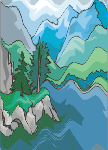

If you wish to plant new evergreens, a family-friendly solution is to first visit the
Arapaho National Forest Service office between SilverCreek and Granby
(between the big Grocery Store and the town of Granby, on the west side of Hwy. 40).
Step inside and pick up all of the literature and souvenirs you want and
ASK for a Tree transplanting Permit. For a nominal fee, you will have a permit
for a half-dozen alpine fir or Engelmann spruce for your family to find and
pluck from National Forest lands to which you will be given a map.
Before you cut dead trees down to the ground, consider cutting good level at a comfortable seating height ....
or use cut them higher to be hitching or fence posts or .... or carved art.

Tip #10 Fireplace versus TV. This is a tough one.
One wants the fireplace and the TV at a comfortable eye-level and seating position.
This is hard to do without them both competing for the same space.
(A "virtual fireplace" playing on the TV is not real.)
What to do? We don't know. A windowless media room does not help
when you need access to brightly lit tasks at the same time you are watching TV.
Thin, lightweight, affordable and large LED screens can placed most anywhere.
Entertainment cabinets are obsolete. They are so heavy to move around and setup
that you can get them for almost free to use as armoires and wardrobes.

 Tip #11: You want railings to let in your view and not to block it.
Tip #11: You want railings to let in your view and not to block it.
Test a railing design in a seating position before you commit to it.
Decks and railings need to be away from overhanging roofs.
Photos below are a typical case of what happens when a deck is built without first
considering where is the roof.
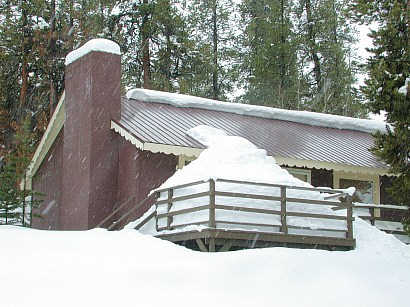
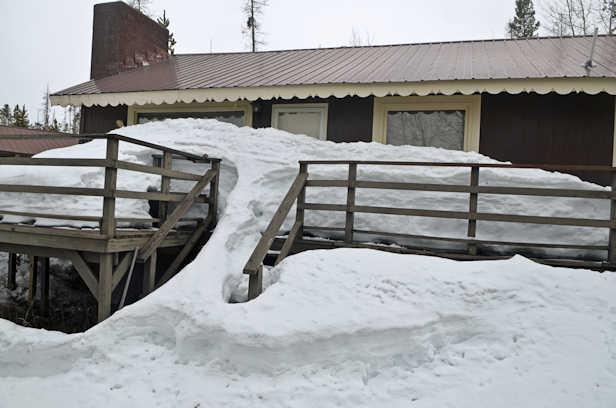
Add another roof line if necessary to keep snow from shedding on your deck and entryways.
If the underside of a deck or balcony is visible, have it built with hidden fasteners
and joiners, like building fine furniture. Galvanized joist hangers will be an eye-sore.
With a little more thought, brackets can be hidden or eliminated just as is done with fine furniture.
Do not screw into a deck's top surface; use hidden fasteners.
Flashing set between the top of the joists and the decking can eliminate streaking from water draining through the deck.
One can also add aesthetically pleasing drainage chutes to direct water to where it should best go.
A railing should not be
"climbable". You have to anticipate what a 3 to 11 year old might attempt.
The air gap between posts is usually filled with vertical "rods" or dowels spaced within 3.5" of each other.
One can use long rectangular panes of tempered glass with vertical gaps 3.5" wide to let the wind
and view through. The gaps between the planes makes it easier to clean them. A railing that is
not
climbable has no footholds for a curious child to use to climb up it. If your deck is very close to the ground,
consider instead having a patio or a terrace with pavers. Then may not even need railings.

Tip #12: Holodeck. Create at least one extension from the main home's rectangle from which
one can see part of the home's exterior from the inside; this could be a room you could add later.
When you have a wing or bayed out portion of a room, consider having the outer-most window of
the bay taller than the rest; Let the next furthest out window be a step down in height.
The bottom window sills are all at the same height to potentially create wraparound counter space.
When viewed from inside, the stepped up windows create a wraparound holo-deck I-Max field of view.
You can get a sense of this opened up bay in some rooms by stepping up the height of window blinds
to create a focal point.
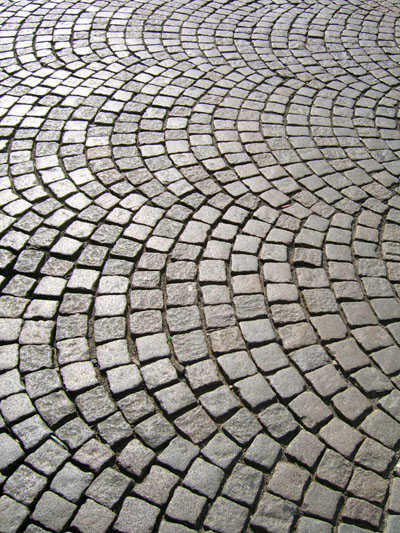

 Tip #13: Stone walls, dikes, terraces and pillars.
Tip #13: Stone walls, dikes, terraces and pillars.
Nothing looks and feels more enduring than stonework. Like a sphinx, it blends in with time as if it had always been here.
Stone construction inside and beyond your home can be a singular and irreplaceable part of your property.

Stones that are fit together in a stable and useful manner are pleasing to the soul.
When they are being fitted together, there is a happy moment each time a stone finds its place in among other stones.
A thick layer of rock along the base of a home gives it all gives a sense of balance and equilibrium.
Sometimes you want a more daring and dynamic effect, a skyscraper thrill ... sometimes you get lucky and
the very ground you own has a curious rock formation. Below are two examples, the first from a home on the market,
the second at a home site calling for someone to work with it and build something fantastic.

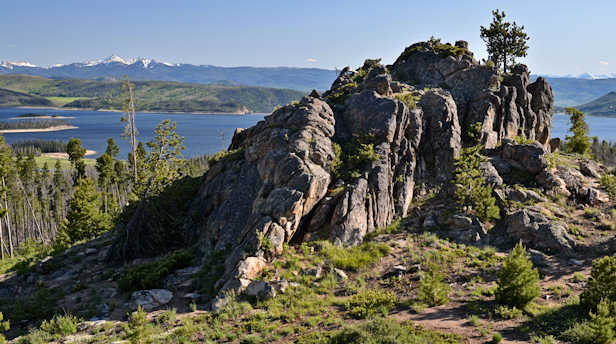
Some properties come with amazing stone already set. Click on photo to
the left for a lake view home. The large formation to the right is on
vacant land.
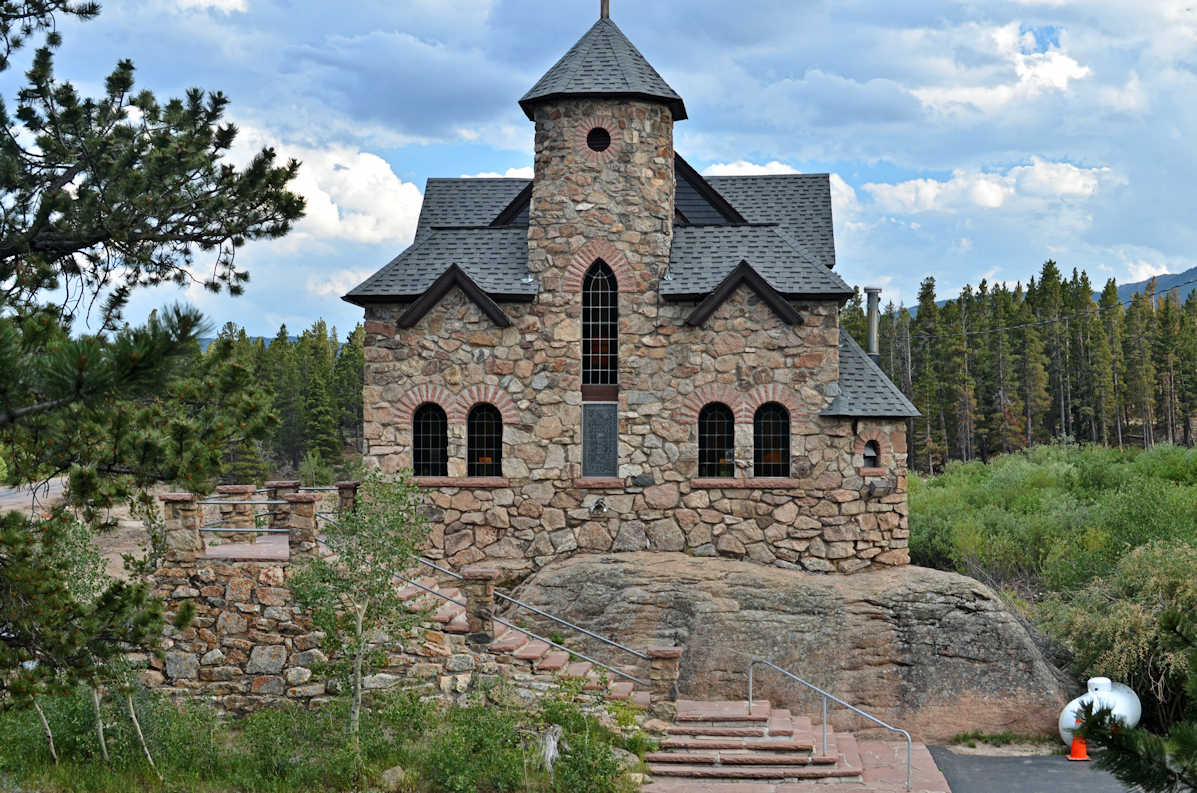

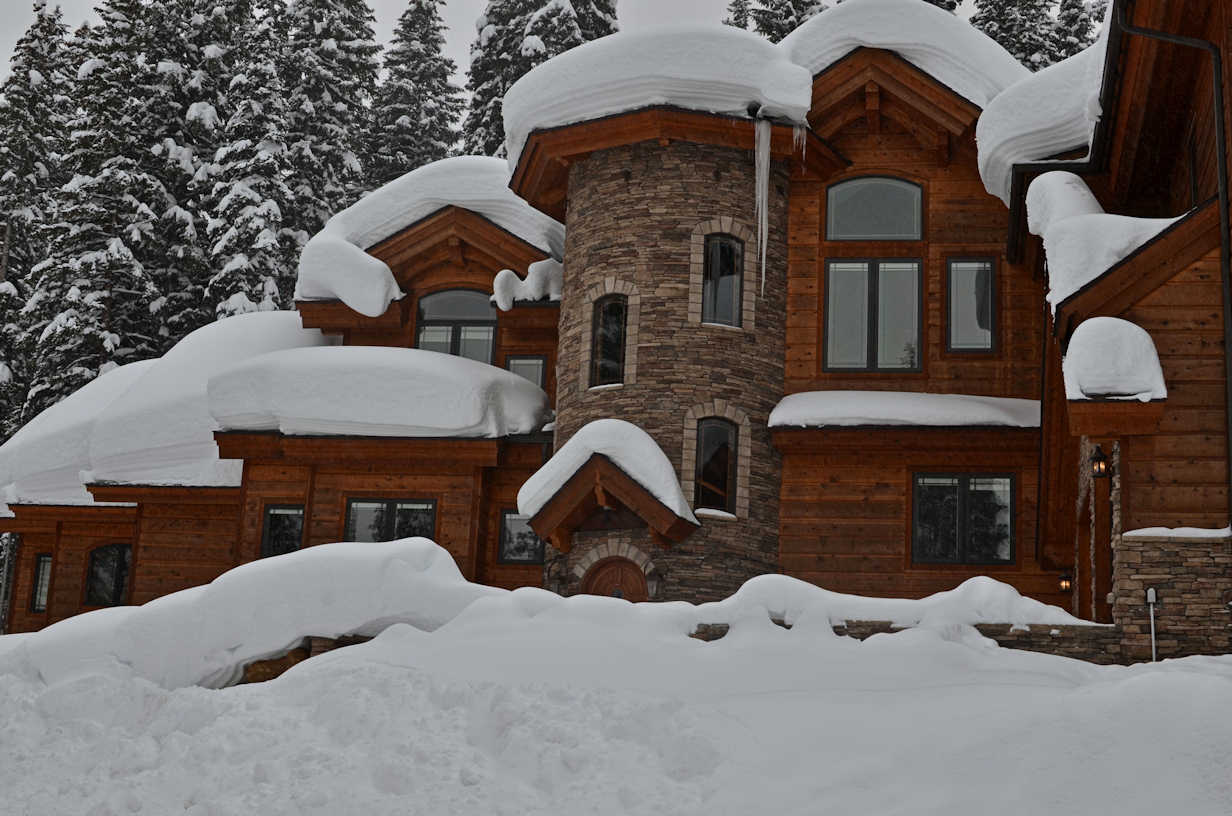
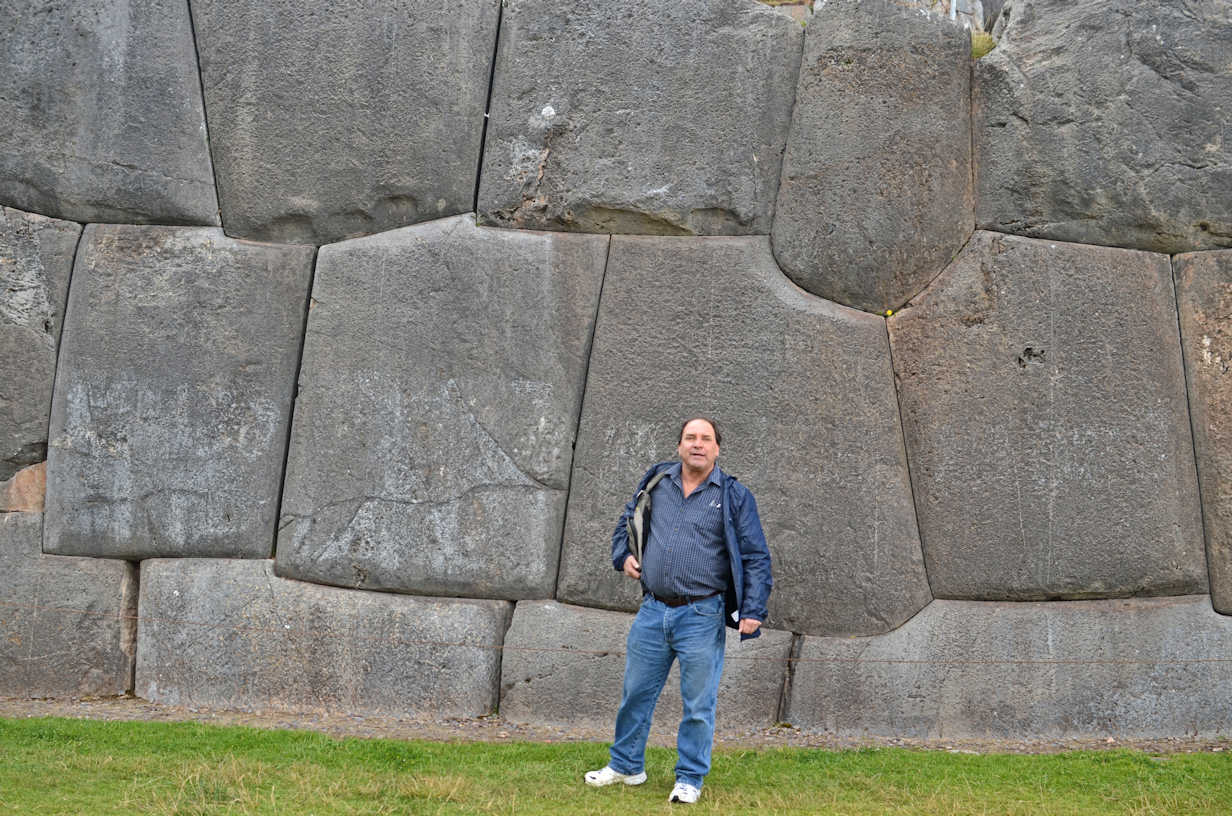
Rocks, hollows and tunnels .... interspersed with velvety green and alpine gardens ....
terraces stepped along a mountain .... streets designed with pavers ....
The ways stones are laid out and installed is as varied as there are masons.
Stonework gives a home a 3-D depth with variations in lighting and shadows ... that only stones can do.
In Grand County, Colorado, if you want to use stones that are already on your property, your immediate supply can be abundant.
Rocks can come out of freshly a dug hole so fast you'd
think that something is adding rocks to the holes as you dig. The more you dig,
the more you get. It's like getting down and making a symphony (or a novel, or this article), every time you revisit some phrasing,
you come up with more or better notes to play.
Landscaping in Grand County is synonymous with moving rock. Move a rock to a
better location and you also
open up its original location for new plants. Rearranging what you already have is simple and effective.


Below are some tips on setting natural stone for a 2-sided wall, fence, pen or the edge of a terrace.
Start with your largest stones and set them with as much of their surface area as possible spread out,
horizontally, across the foundation of earth, or perhaps, crushed and compacted
stones, or concrete.
A gravelly base helps to draw moisture into the ground and away from the stone work where it could
freeze and or make the settling uneven.
With all of the rest of the stones that go higher
up, your instinct may be to set them also with their
flattest area facing
down, however this is the opposite of what you do to create
stability.
Set each rock so that its flattest surface is on top facing upwards so that it can be built upon.
Instead of setting stones on directly top of each other, you want to bridge the gaps between stones;
this helps to lock everything together. When you have it right, gravity is your friend.
What gravity has not already done, you can initially speed along by compacting your rocks
for your base layer. . For small rocks, there are walk-around robots made for the job.
Your heaviest sledge-hammer or splitting axe may be adequate.
The smoothing effect
of this tamping (enhanced with water to lubricate everything) removes creases as when
one shakes out laundry and irons it with a bit of moisture.
When you lay stones, big or small, it may seem intuitive and best to set their flat surfaces facing down.
This is almost always wrong. As a builder, you strive to have a level surface available to support the next tier up ...
you are always looking ahead. Aim to make stable platforms on top for
additional rock or something ornamental
you may set on top. If at any point you stop work on a wall, its level surfaces on top can be convenient little platforms.
Someone can add on later, if the lower layers are a good foundation. With time, the rocks will settle. If the very top
level is level, then it is easy to correct the settling with the next course which is set with its flat surfaces facing upwards.
If a rock is shaped a bit like a wedge, the thicker and heavier end can
be set downhill to counteract the slope of the ground.
There are many ways to bring stones (or fabrics) together for a purpose.
Only a fraction of the wide range of possible and/or random arrangements
are of interest as living space improvements or of aesthetic appeal.
A heap of stones, from an avalanche, a washout or a dump truck is not anywhere as stable as it could be
if each stone were set from the
beginning with a good foundation, one-on-two, two-on-one.
In mathematical physics, every randomly attainable arrangement is a point
treated equally with all other points.
Your particular state is one of those random points. What interests
mathematical physicists is a precise numeric quantity called entropy.
It is a measure of how much a system has run down and aged. Extra
effort up front to create a sturdy structure can help hold back the
ravages of time and decay.
The inevitable increase of entropy that occurs when maintenance is not
performed is not so great for stone as it may be for a wooden structure.
One can not use physics to tell you what Suzie will buy on Broadway.
Picking out which events have interesting alignments and aesthetic appeal is not fully within the scope of mathematics.
Only a portion of what we do is computable. One can use mathematics to understand why certain structures are more
stable or efficient. If there is a parameter you want to minimize, calculus is there to find these minimals
(a first-order deviation from them
causes no more than a weaker second-order change).
Gorgeous designs come to us for free from nature ... and gravity. The way drapes and fabrics hang off
a body, the way light strikes it and comes to our eyes, this all comes for free. For more energy intensive
projects like setting stones or rearranging your furniture (or life), you have to make an effort.
How it all turns out depends on how each stone and item is selected and set.
 How to Set Stones: start with the largest one's first, even if they are not touching each other.
How to Set Stones: start with the largest one's first, even if they are not touching each other.
Start with the largest rocks, maybe one of them is already an outcropping. Fit them together as close as
you can while most always keeping their largest and flattest surfaces on top, facing upwards and close to level.
Use smaller rocks to fill in voids between the big rocks and to help lock everything together.
Even very small rocks, placed by hand, will add to the aesthetic appeal of the whole project.
Small unimportant stones can play a big role as keys which fit in gaps to lock everything together
distribute weight from above over a wider area below. The keys can be behind larger rocks it the wall
is thick enough. You don't want the smaller rocks to do the opposite of a lock and instead act like a wedge
pushing the larger stones apart.
Set each rock so that it lays across the joints below it, as though it were bridging over the gap.
This helps to distribute the weigh and create a stable structure. Vertical gaps more than an stone high
are not wanted. Do not set stones between vertical gaps in a manner that wedges the big stones apart.
There is an aesthetic difference between a slope that is a pile of rubble, ready to shift or slide with a slight disturbance,
and rocks that have been set two one, one-on-two from bottom to top. Stability has an aesthetic appeal.
That's not to say that dynamics is to be left out, as in the artful lines of an arch or a flying stairway.
You can slowly build a dike, terrace or a retaining wall
with unreinforced, drystone work,
in places where there are no severe consequences
if/when it fails.
Perhaps this all takes a Scottish leaning for pulling stones out of fields and stacking them to make fences, pens and corrals.
A Scottish obsession with earth and stone ... an irresistible inclination to move
stones out of fields and put them to a higher use.
The material is free. It just needs your attention.
When you raise a rock from being an obstacle in a field to being a
supporting element in a wall or foundation,
you get a double bonus; the wall gets bigger and the void in the field
from the rock's absence is a new place for plants to grow.
You get all of these benefits without even mixing mortar or concrete.
If you have raw south facing area, don't expect plants to quickly inhabit it.
Move rocks to the southern exposures where its too dry and sunny for plants to easily grow.
You'll create greener Eden on the other exposures and while a few plants and critters establish
homes in the south-facing rock. A marmot likes a sunny front porch as much as you do.
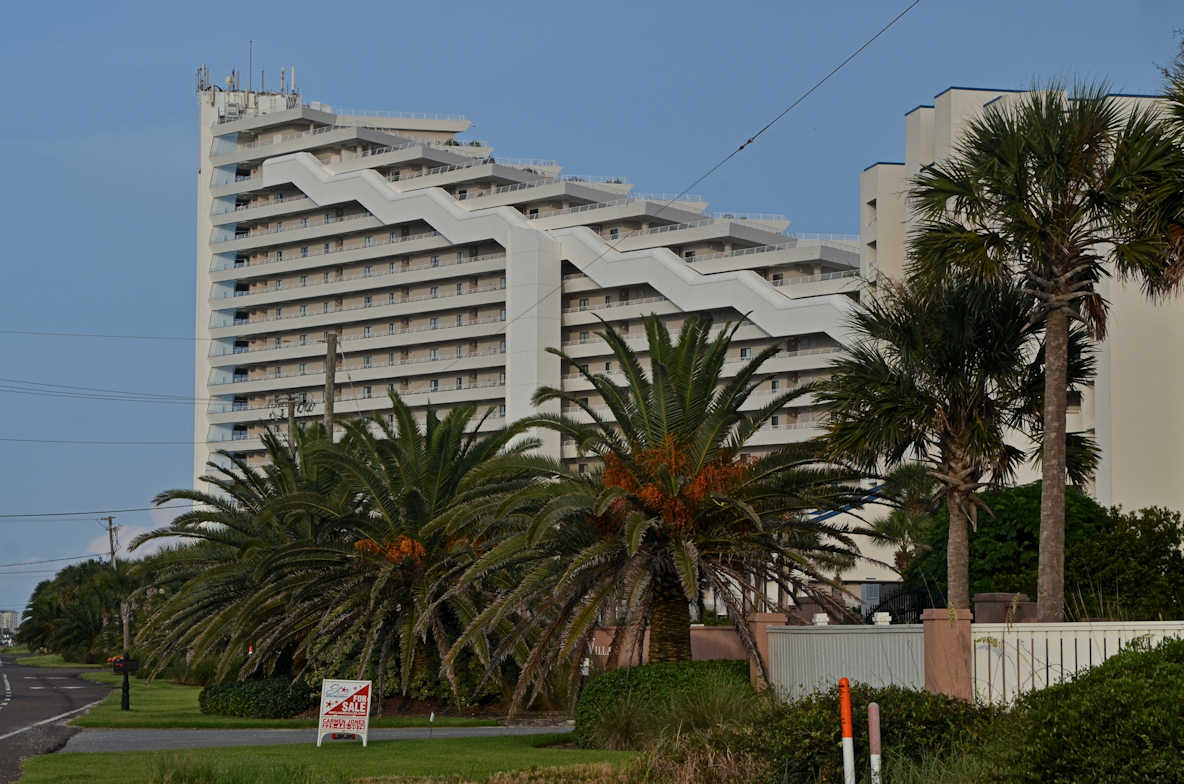 Terraces come in many practical forms.
Terraces come in many practical forms.
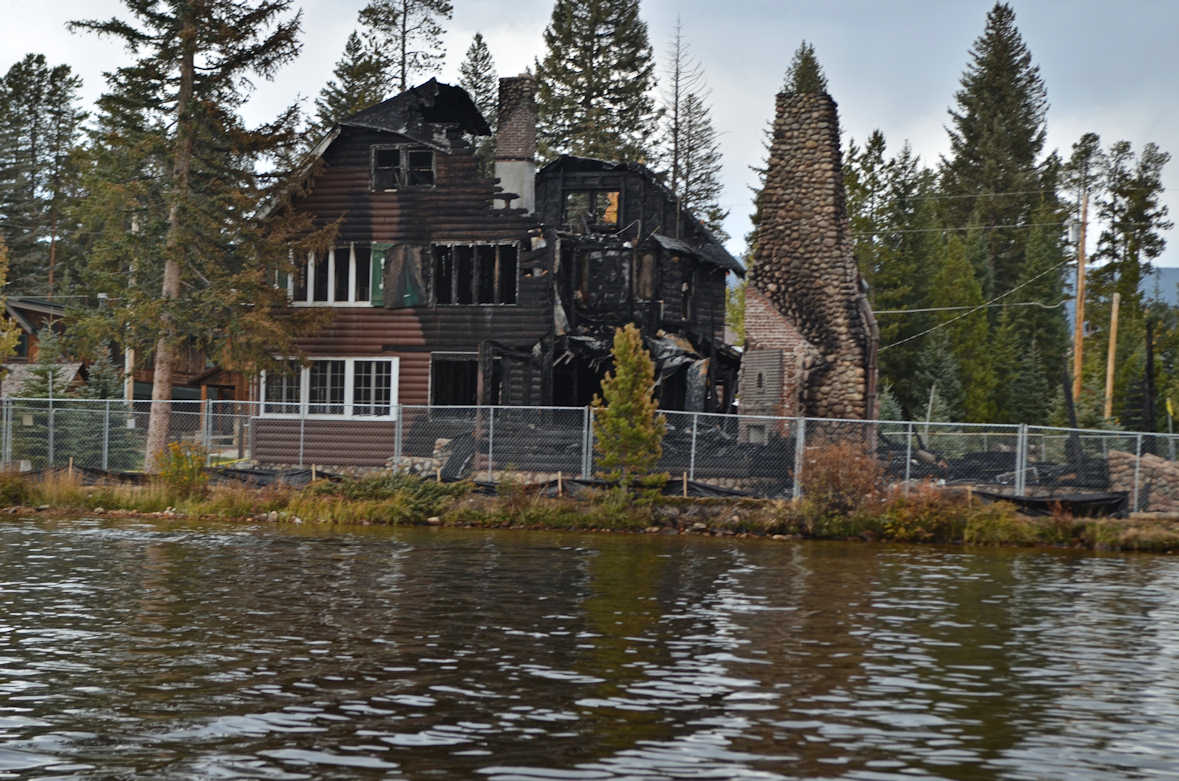 Even after she burns, the stonework stands tall.
Even after she burns, the stonework stands tall.
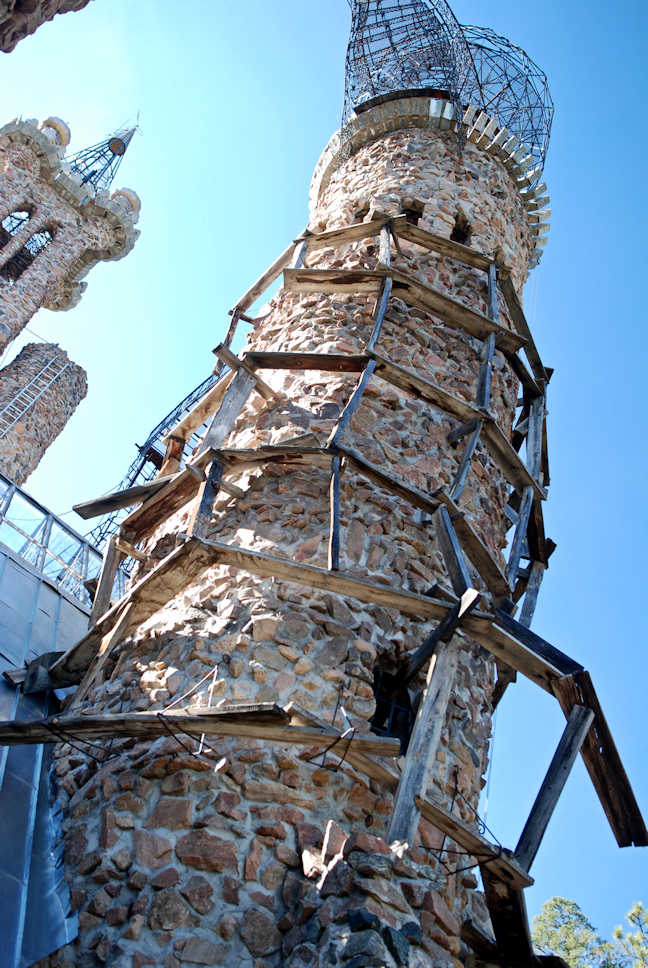 Stonework .... some take it to the sky.
Stonework .... some take it to the sky.




 Tip #14: Winter Access. Plan on having lots of space to move snow just once.
Tip #14: Winter Access. Plan on having lots of space to move snow just once. Tip #15: Wings.
Tip #15: Wings.
A reason why people like decks, patios and balconies so much is because they provide a perspective of your home from outside.
They function as wings. An interior room that projects out to where one
can look back at one's home, in effect, brings outside elements
inside.
Let's build something! We have been inside and photographed a great many homes.
Just as Grand Lake community has no chain restaurants and no chain motels, each home
is an individual creation. Below we help you imagine positive strengths and features that
go into a mountain home that is integral to happy times in Colorado's high country.
The tips below are not in order of importance or what you can implement right away.
If you are fortunate to have virgin land ready for its first home, congratulations.
Being able to do new construction .... or anything new and away from the daily grind .... is a blessing.
Take time to get to know your property in stages while you happily let the dreams
and needs materialize.
Here we give you tips for your hope chest and showcase designs to encourage you to implement your own bold and intelligent designs.
Deep and extended eaves help to shed snow and rain away from your
home and railings. Anything to help with drainage around a foundation is
good.
A chalet-like eve creates a visor-like effect to reduce glare.
Allow for at least 24" of eave extension. Insulate the eaves to reduce
ice damming on the roof.
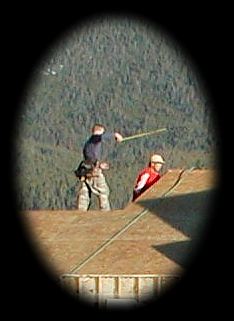
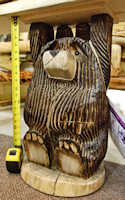 The best way to get exactly what you want with the latest materials and advantages
The best way to get exactly what you want with the latest materials and advantages
Click here » for a kitchen design that used its deep counters to put refrigeration under the counters.
We are sharing the designs featured here
with the larger
Pinterest
community where you can get more inspiration. Let's build
something new, this year!
To start from fresh with virgin land, see our list of vacant
land sorted by price.
This is the best way to have everything customized for your family
with the latest and best materials.
A more affordable alternative, although not necessarily easier, is
to upgrade an already existing cabin.
Click here for » basic
cabins for under $200,000. Click here for a » full
range of larger homes.
Each home presentation has an inside tour with photos large enough
for you to get design ideas.
Soon we will add more links in this portal to excellent designs
that we have photographed.
Only a few of the designs will be from homes that are currently on
the market.
We hope to inspire vacation cabin seekers to see what they do.
...
 This Pinterest link is preset to search
for Dream Home Designs.
This Pinterest link is preset to search
for Dream Home Designs.
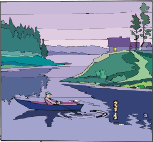 Jump to Homes
... Land ... Businesses
... Weather .. What's
New
Jump to Homes
... Land ... Businesses
... Weather .. What's
New
Send questions and inquiries via email to relax@MountainLake.com
We prefer that you speak to us directly by telephone or walk into
our office on main street, just past the the town square and
one block from Grand Lake's public beach. Please call us:
![]()

to .. Main Menu .. ..
to Real Estate choices ..
Enjoy this media while you peacefully dream of visiting Grand
Lake.
»» .. to splash page »» www.MountainLake.com «« Jump to Homes ... Land ... Businesses ... YouTube .. What's New
..
Photos (and videos) from this website can be used if you give
a photo credit as follows: photos courtesy of www.MountainLake.com
© Text & Structure of this site is Copyrighted 5/1/96.